Feature
Partnerships Achieve Creative Connections Between Coding, Music, and Science
Connected Science Learning February–March 2023 (Volume 5, Issue 1)
By Pascua Padró-Collazo, Isaris R. Quiñones-Pérez, Rafael A. Arce-Nazario, Joseph Carroll-Miranda, Lizzette M. Velázquez-Rivera, Brenda Lee Estévez-Moreno, and Lilliana Marrero-Solís
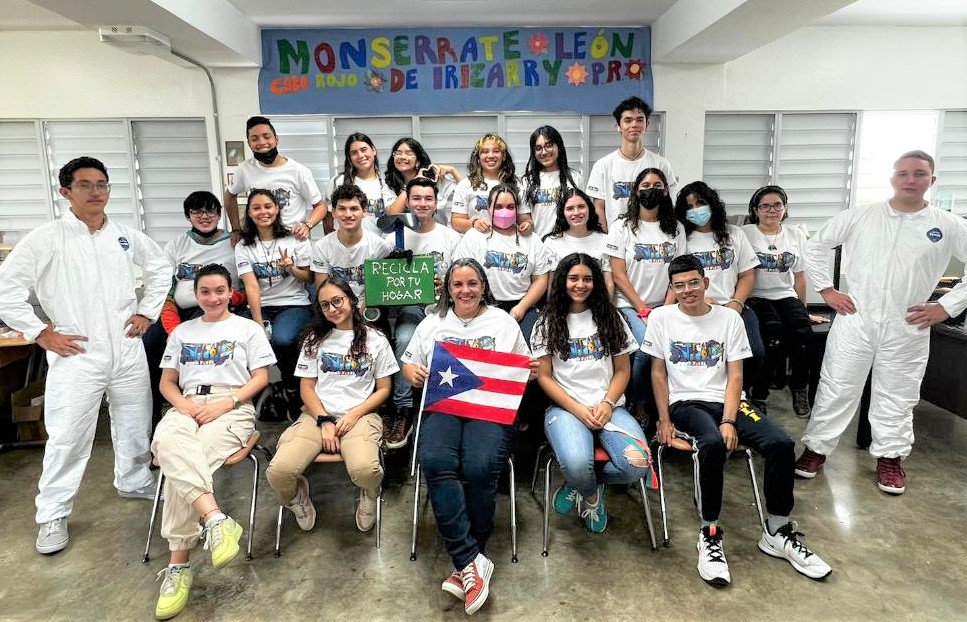
Our increasingly digital and data-intensive world has placed computer science (CS) at the center of STEM education. Scholars and national organizations have prioritized the development of computational skills for all students (National Science Foundation 2016). However, these calls to action cannot be successfully addressed without examining and attending the factors that contribute to the disparities in CS participation (Margolis 2017). Latinos are the fastest growing population in the United States (US) and yet are underrepresented in CS disciplines, degrees, and workforce (National Center for Science and Engineering Statistics 2019). This inequality makes the US STEM educational landscape strongly dependent on Broadening Participation in Computing (BPC) of Latino students.
Unfortunately, CS education in Puerto Rico (PR) is an example of the difficulties and disparities in CS participation of predominantly Latino populations within the US public education system. The overwhelming majority (>80%) of the Puerto Rico Department of Education (PRDE) schools do not offer CS education. Out of the 843 PRDE schools, less than 120 offer some type of computing experience (i.e., robotics, HTML, or introduction to programming). Most of the schools that do offer CS experiences are vocational or technology magnet schools. Nonetheless, the PRDE has two official course codes for CS stand-alone courses (elementary and high school). One of these courses is a result of the National Science Foundation–funded project ECS4PR Research Practice Partnership that (a) translated to Spanish the Exploring Computer Science (ECS) curriculum, (b) adapted this curriculum to the Puerto Rican high school context, (c) offered ECS teacher professional development, (d) trained teachers as ECS facilitators, and (e) trained teachers to implement the ECS curriculum in their schools.
The concern for BPC of the Latino population within the US also gave rise to Remezcla, a Broad Implementation collaborative project designed to increase the coding and computer science skills of Latino and Spanish-speaking students in the continental US and Puerto Rico. Remezcla (the Spanish term for remix) created and implemented, in afterschool and summer camp formats, an informal computer science curriculum based on the use of a music remixing software platform called EarSketch. EarSketch teaches students computer science coding through music remixing and has been shown to increase both students’ computer science skills and their intention to persist in computer science (Magerko et al. 2016). Results from surveys administered to the Remezcla PR students before participating in the afterschool program confirmed the limitations of CS education in PR. The majority (slightly over 70%) of the students (N=113) stated not having any CS experience within or outside the school context prior to Remezcla. In addition, a little over 90% of the students stated not having prior experience with EarSketch.
This article shares how the establishment and strengthening of partnerships have provided Latino students from Puerto Rican schools innovative, tailored opportunities to learn coding and develop computational thinking.
Remezcla: A Partnership That Generates Partnerships
Partnership between Remezcla Puerto Rico and Remezcla Atlanta
The Georgia Institute of Technology (GT) developed and tested EarSketch, which proved successful in engaging students in coding and computer science—particularly girls and underrepresented minorities. This prompted its incorporation to multiple educational programs; however, EarSketch’s benefits were limited to English speakers, and the development of its music library had been primarily influenced by the cultural and linguistic inclinations of US urban youth. In response to this limitation, the Remezcla partnership between GT and the University of Puerto Rico Rio Piedras (UPR-RP) was established. This partnership allowed the development of EarSketch’s cultural and linguistic innovations and Remezcla’s informal learning and culturally responsive curriculum.
Regarding EarSketch, the partners worked collaboratively to
- select, create, and incorporate to the EarSketch library hundreds of traditional and contemporary Latino sounds, beats, and musical samples, and
- develop a Spanish version of the platform so that the displayed language can be easily switched by the user to support the natural language fluidity between English to Spanish and vice versa, characteristic of Latino linguistic expression within the United States and Puerto Rico.
Remezcla’s informal learning curriculum is another important product of the partnership between GT and UPR-RP. Unlike the curriculum used within formal school-based CS programs, the Remezcla informal learning curriculum emphasizes a less-structured mix of music and narrative, designed to allow students to incorporate sounds that they collect within their community and can be intertwined with musical clips from the EarSketch collection. These self-collected sounds can also include people talking or singing, adding to the explicit connection between home and community, and allowing students to connect in a culturally authentic way with their computational musical creations. This curriculum was also developed and implemented in English and Spanish.
Partnerships between Remezcla and teachers
Remezcla offered its first summer camp and after-school program the summer and fall of 2021 respectively. Word of these Remezcla offerings reached several educators, provoking special interest in two science teachers committed to evidenced-based, best teaching-learning classroom practices. These interests allowed them to readily view Remezcla’s potential to enhance their students’ active learning processes. Their determination to integrate Remezcla and EarSketch into their classroom settings led us to work collaboratively as partners in The Code, Science & Music Remix Project; and the STEAMezcla Project.
The Code, Science & Music Remix Project
Dr. Lizzette M. Velázquez Rivera is an environmental sciences (ES) curriculum and instruction professor at UPR-RP. She offers science methodology courses for education undergraduates majoring in ES. Her curriculum and teaching practices are focused on problematization in learning integrating problem/project-based and service learning. She learned about Remezcla in a friendly conversation with Dr. Isaris R. Quiñones Pérez (Remezcla PR Project Coordinator) who showed her a brief presentation of the EarSketch platform. She quickly shared ideas to create a project. Further conversations led to the creation of the Code, Science & Music Remix Project. This Project is an educational experience focused on problematization in learning and the curricular integration of CS to the ES classes taught by preservice students at UPR-RP Laboratory Elementary School. It is designed to develop computational thinking skills while learning about the Sustainable Development Goals (SDGs) and use music programming to raise awareness and promote environmental conservation.
Lizzette suggested using her science laboratory technician, Lushley Delestre Velázquez, to offer the EarSketch workshops to the fifth-grade students (see Figure 1). Remezcla staff trained Lushley (approximately six hours). Remezcla also worked collaboratively with Lizzette and Lushley to design the workshops for the students. Finally, Lushley offered the workshops to the 22 fifth-grade students face-to-face during six 50-minute ES class periods (see Table 1).
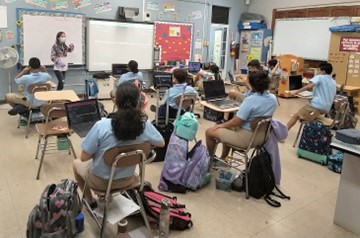

Click here for a larger version
Learning to code with EarSketch allowed the students to express their conceptualizations of the Earth’s major spheres (atmosphere, hydrosphere, lithosphere, and biosphere) through music. Students wrote a descriptive paragraph to explain their musical compositions. One student wrote:
"The layer of the Earth that inspired me was the hydrosphere. The sounds that inspired my song segment were of the resource water. One sound represents the life that water gives us, without it there would be no life… When I listen to this segment of my song, I want to convey tranquility and the importance of water for our plants and life on the planet."—E.M.V.
On Planet Earth Day (April 22, 2022) the students and the preservice teachers presented their musical compositions along with a description of their ES content learning processes to the school community. Another fifth-grade student’s description reads:
"The sounds of my musical composition were inspired by the Earth’s layer. The sounds I selected for my song segment can be described as natural, but at the same time, with a moving rhythm. The sound from my song segment that I liked the most was the flute. It sounds and makes me feel like I am in a bamboo forest, when the wind hits the bamboo, and that wonderful melody is produced… One way in which we negatively impact the natural sounds of our environment are: loudspeakers, construction, vehicles, among others. It is important to conserve the environment because without it there is no life and oxygen would not be produced, which is essential for the organisms that inhabit the planet… Finally, making this musical segment was fascinating. While I was learning to program, I created my own song about environmental conservation." —Y.S.O.
In this way, the fifth-grade students raised awareness about our need to save the environment and live in harmony with the SDGs. This final activity was broadcast by different local news media like WIPR, Puerto Rico Post, and El Vocero. Also, a description of the project was published on the school web page. The fifth-grade students’ musical compositions and their accompanying descriptions can be accessed here.
The STEAMezcla Project
Brenda Lee Estévez is a science teacher at the Monserrate León de Irizarry High School in Cabo Rojo, Puerto Rico. She also leads the Matcien Organization, an afterschool club for high school students interested in STEM. For several years, she had been inviting college students as workshop facilitators to expose Matcien students to programming skills. She observed that although students were initially enthusiastic about learning CS, their interest faded as the semester progressed because the workshops’ activities and products lacked the clarity required to motivate the students to share their achievements.
She saw a promotion of the 2021–2022 Remezcla afterschool program and decided to apply despite it specifying that the program was restricted to schools located in the Metropolitan area (roughly 100 miles away from her school). Remezcla had established this restriction because the workshops were meant to be face-to-face. However, the COVID-19 pandemic forced us into virtual meetings, which had the favorable consequence that the schools’ location was no longer an obstacle for participation. Brenda’s students shared her enthusiasm and drive. During the 2021–22 Remezcla afterschool they participated alongside their teacher in a local (April 6, 2022, Education Week, Faculty of Education, UPR-RP) and a national (March 17, 2022, GoSTEM’s 10th Annual Latino College and STEM Fair) educational congress, sharing and talking fervently about their musical creations.
Brenda was assigned to teach Environmental Sciences to senior students for the 2022–2023 academic year. She had taught a similar course (Earth Sciences) before but at the ninth-grade level. As with the younger students, she originally planned to teach a project-based course. However, she later anticipated possible difficulties implementing this strategy with older students who tend to be harder to motivate and more set on their individual interests. To address these concerns, she decided to incorporate STEAM-related activities that would enhance engagement and encourage critical thinking and creativity. She realized that Remezcla was an excellent opportunity to insert the technology and arts component of the STEAM-focused ES course. Among other advantages, it would also contribute to the achievement of one of the course’s objectives: developing in students a sense of belonging regarding their culture, environment, and nationality.
To test her ideas, Brenda integrated Remezcla into one of the three ES sections she teaches. She calls the project STEAMezcla. In spring 2022 she administered a survey to all the students that were considering taking ES in August 2022. Twenty-two students were chosen for STEAMezcla based on their interests in STEAM and coding. The section met five times for one-hour periods per week: four guided by Brenda (face-to-face) and one guided by Lilliana Marrero, one of Remezcla's workshop facilitators, through video conference (See Figure 2).
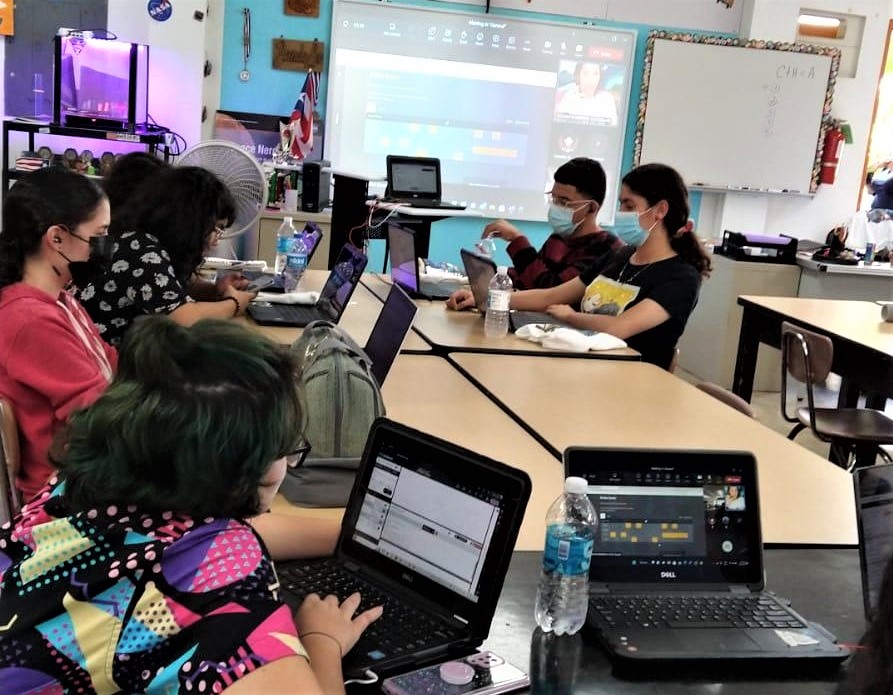
For all three sections, the mid-semester project consisted of simulating the interaction between a pollinator and a flower using homemade and recyclable materials (see Figure 3). In the final project phase, the students artistically express their appreciation for the process of pollination, which can include graphic arts, creative writing, and music. STEAMezcla students are required to write creatively about their simulations and compose accompanying music.
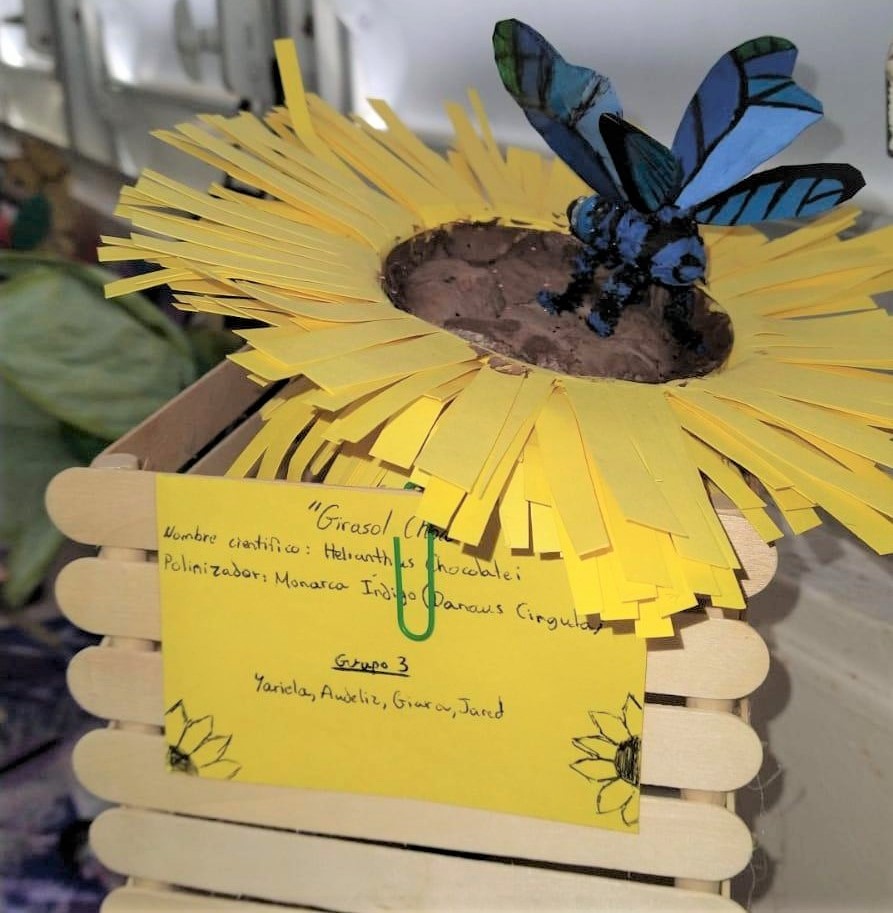
The effects of the changes introduced by STEAMezcla will be formally measured in May 2023 using validated evaluation instruments. However, some clear signs that students are responding well to the approach are:
- Comparing impressions between Brenda and other ES teachers, students in the STEAMezcla exhibit greater availability and desire to go beyond the required class work. For instance, all 22 students are voluntarily helping to create a school garden for pollinators and sustainable agriculture, compared to only 5 of 77 students from the other sections.
- 21 out of 22 students from STEAMezcla earned an A as their ES grade (first semester of the STEAMezcla implementation), compared to 36 out of 54 from the other sections.
- All STEAMezcla students have signed up to participate in ES-related NASA challenges while only one student of the 77 from the other sections signed up.
- Students in STEAMezcla are more eager to share their musical products with friends outside the classroom. Their sense of accomplishment in creating music through code is palpable.
Partnership Lessons
Literature stresses the challenges associated with the creation and sustainability of school-university partnerships such as
- lack of an interdisciplinary research organizational structure, culture, and infrastructure (Connors et al. 2021);
- intermittent professional development due to teacher/staff turnover, and difficulties leveling school-university status hierarchies and building trust relationships (Carney et al. 2019); and
- skepticism and negative perceptions of research, distrust of outsiders, and feeling pressured to participate (Gibson, Bridges, and Barnes 2019).
Phelps (2019) summarizes the challenges faced by school-university partnerships in three key differences between each institution’s politics and operation: (1) organizational structure, (2) discourse practices, and (3) power relations. He proposes creating healthy and sustainable partnerships by acknowledging and addressing these differences. That is, intentionally and collaboratively building the partnership’s organizational infrastructure and shared meaning, and trusting relationships among partners.
Aware of these challenges and having experienced difficulties retaining the participants of the Remezcla after-school programs, we were pleasantly surprised by the ease and joy of the partnerships that gave rise to the two projects described above. Our main take-home message is that partnerships do not have to be hard to create or sustain. Even better, the results of effective partnerships are greatly rewarding. Based on Hora and Millar’s (2011) classification of partnerships we attribute the success of these partnerships to their collaborative nature and briefly describe how each partnership achieved authentic collaboration (see Table 2).
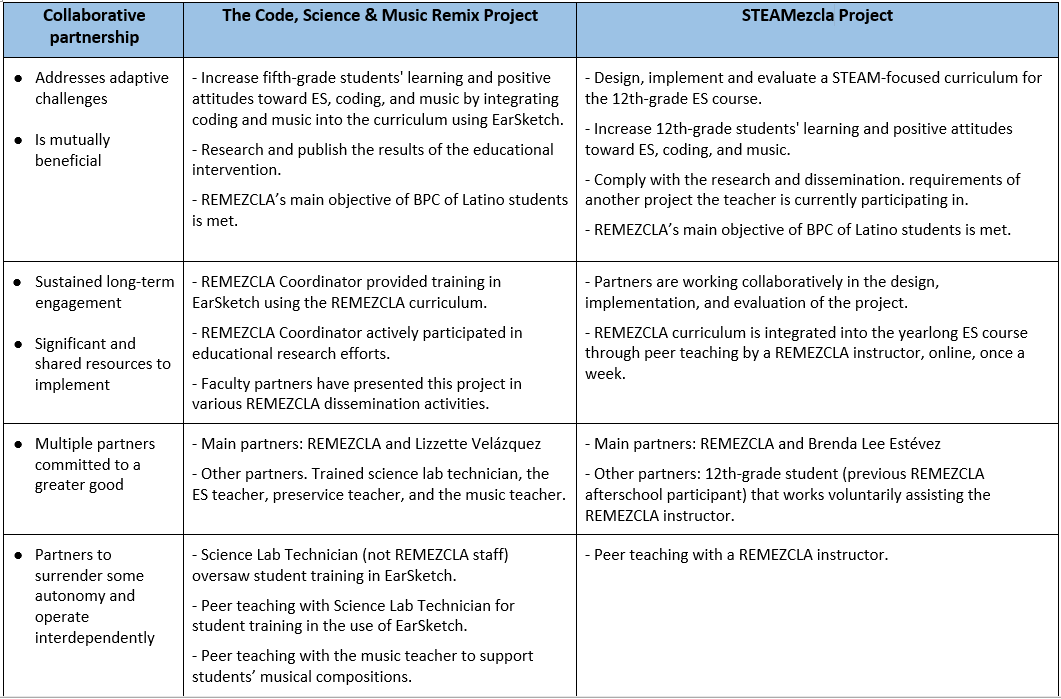
Click here for a larger version
In addition, we identified two key characteristics of the partners that facilitated the creation and sustainability of the collaborative partnerships. First, both partnerships were initiated by the school partners. Building a collaborative partnership with Remezcla became a way to address adaptive challenges concerning: (a) broadening their students’ participation in computing, (b) enriching their environmental science course curriculum with the integration of music and coding, and (c) contributing to their educational research interests. These high-level adaptive challenges—focused on interdisciplinary educational outcomes—fostered the integration of other partners also committed to maximizing educational experiences for students. It is noteworthy that both school partners had previous friendly and professional relationships with REMECLA staff. This facilitated the school partners’ willingness to initiate and follow up on designing their projects based on a collaborative partnership with Remezcla. Despite emerging from the school partners’ specific needs, Remezcla also benefited from the partnerships. The partnerships were mutually beneficial because all partners shared the objective of broadening Latino students’ participation in computing.
The second key characteristic that fostered collaborative partnerships is that both sides of the partnership were flexible to change. All partners had to adapt their regular curriculum to the new teaching-learning-assessing practices that would achieve the student learning objectives and outcomes established by the partners. Remezcla’s adaptation required developing with the school partners different implementation formats than those originally used by the program (after school and summer camps). In both partnerships the Remezcla curriculum, originally designed for informal educational settings, was integrated into the formal academic course load. This formality required, among other things, the measurement of learning outcomes according to the grading mechanisms established by the PRDE. This adaptability contributed to the sustainability of the partnerships by inviting the partners to surrender part of the autonomy associated with their operation as independent organizations and acknowledging and welcoming the benefits of operating interdependently.
The sustained, long-term engagement, and the significant and shared resources required to integrate the Remezcla curriculum into the schools’ ES curriculum also contributed to the creation and sustainability of collaborative partnerships. The partnerships spanned from the initial discussion of ideas, objectives, roles, and responsibilities for curricular design throughout the training and implementation of the projects. Members of the Code, Science & Music Remix partnership describe the project in the article “Integration of science and music to conserve the environment through computational thinking” (Velázquez Rivera et al. 2022). The STEAMezcla Project is still being implemented; however, the teacher is planning to use this project to comply with an action research requirement of another project she is currently participating in. Therefore, both partnerships have been sustained beyond their implementation period and have shared multiple human and material resources along the journey.
Final Recommendations
The lessons shared in this article are concrete ways in which coding was integrated to ES courses at the elementary and high school levels. This integration occurred by establishing partnerships between the teachers and Remezcla. It is within this overall context that we share the following recommendations for teachers and schools interested in providing their students with coding and computational thinking opportunities.
- There are many ways of broadening student participation in computing. Establishing partnerships allows the effective use of multiple sources of knowledge, skills, and resources. University departments and industries focused on CS usually have grants that require school and community outreach. Because of the partnerships, the projects described above were implemented even though the school partners had no prior experience in CS. In fact, the teachers participated with their students in the training provided by Remezcla. In summary, contact your nearest CS Department or industry and ask about their efforts to BPC.
- STEM and STEAM efforts encourage interdisciplinarity. CS can be integrated into your curriculum. Determining how to do this integration will be an important part of the partnership, especially if the school partner lacks prior knowledge in CS. There are many resources and programs for CS integration to a wide variety of K–12 courses. Once again, build partnerships that can make these resources available to you and your students.
- Leverage partnerships and their CS educational interventions for academic and professional networking. Most of the institutions and industries that enter educational partnerships are eager to recruit, evaluate, and disseminate the processes and results of these efforts. When leveraged wisely, the benefits you and your students receive from these partnerships can spawn way beyond participating in a workshop.
We hope that our experiences with The Code, Science & Music Remix Project and The STEAMezcla Project serve as examples and inspiration for other teachers that may be interested but struggling with how to enrich and strengthen their curriculum and their students’ learning processes with computer science.
Pascua Padró-Collazo is the Remezcla PR evaluator, Isaris R. Quiñones-Pérez is the Remezcla PR program coordinator, Rafael A. Arce-Nazario is the Remezcla PR PI and a Computer Science Department professor, Joseph Carroll-Miranda is the Remezcla PR CoPI and a Graduate School of Education professor, Lizzette M. Velázquez-Rivera is a School of Education professor and the creator of The Code, Science & Music Remix Project, and Lilliana Marrero-Solís is the workshop facilitator of The STEAMezcla Project and a computer science graduate student, all at the University of Puerto Rico Río Piedras in San Juan, Puerto Rico. Brenda Lee Estévez-Moreno is the environmental science teacher of The STEAMezcla Project and teacher in charge of the Matcien Organization in Cabo Rojo, Puerto Rico.
Acknowledgments
The Remezcla Puerto Rico Project is supported with funding from the National Science Foundation, Award No. 2005818. Special thanks to the fifth and sixth authors’ students who actively participated in the two projects described in this article. We also acknowledge the collaboration of our partners with the efforts that led to the writing of this article: Diley Hernández, Jayma O. Koval, Douglas Edwards, Jyoti Kaneria, and Jason Freeman, at Georgia Tech; Tom McKlin, Taneisha Lee, Emily Bryans, and Lorelei Cooper at The Findings Group; and Michelle Borrero and Brenda Santiago at the UPR Center for Science and Mathematics Education Research.
* Opening photo by Brenda Lee Estévez. The STEAMezcla Project students and teacher.
citation: Padró-Collazo, P., I.R. Quiñones-Pérez, R.A. Arce-Nazario, J. Carroll-Miranda, L.M. Velázquez-Rivera, B.L. Estévez-Moreno, and L. Marrero-Solís. 2023. Partnerships achieve creative connections between coding, music, and science. Connected Science Learning 5 (1). https://www.nsta.org/connected-science-learning/connected-science-learning-february-march-2023/partnerships-achieve
Computer Science Environmental Science Inclusion Interdisciplinary STEM Middle School High School Informal Education


